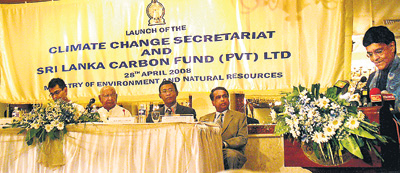
Lanka’s private sector to drive Carbon Credits
Behind every crisis, there is an opportunity. Climate Change is predicted as the biggest crisis faced by mankind and will badly hit developing countries like Sri Lanka. But an opportunity has arisen to earn valuable foreign exchange through mechanisms adopted in the fight against Global Warming. Carbon Trading or selling Carbon Credits earned through Green House Gas (GHG) reduction projects is becoming a lucrative business around the world. To facilitate this, the Sri Lanka Carbon Fund was launched last Monday at a distinguished gathering which included Nobel Laureate Prof Mohan Munasinghe. The main role of the Carbon Fund will be to assist companies and other parities to verify their Carbon Credits and sell them in the international Carbon Market. Addressing the gathering, Dr.B.M.S. Batagoda, CEO of the Carbon Fund, said the fund will bundle the Carbon Credits earned by smaller companies and sell it to international buyers who usually prefer to buy a larger volume. The Carbon Market is demand driven and the prices of a Carbon Credit may vary depending on demand and supply. At present a Carbon tonne is traded for around US$14 and expected to increase as more and more countries start buying carbon credits. “We should not sell our Carbon Credits cheaply, we should claim a good price for it that can then be used for sustainable development,” noted Prof. Mohan Munasinghe. Reflecting the importance of adopting a sustainable development path, he said that developing countries should not take the same destructive path taken by the industrialized countries which increased global warming. Sri Lanka has the potential of starting many Clean Development Mechanism (CDM) projects that could have Certified Emission Reductions (CERs), each equivalent to one tonne of carbon dioxide. However, the project verification process is very rigorous involving a lengthy process. The CDM project investor should first decide upon the project, decide on the Green House Gas reduction methodology and then approach the Designated National Authority (DNA) for approval. The DNA will verify the project against the national CDM policies and approve accordingly. The project then has to be approved by an independent party known as Designated Operational Entity (DOE) in order to reach its final approval cycle at CDM Executive board of UNFCCC (United Nations Framework Convention on Climate Change). When the consultancy fee and legal charges add-up, the cost of the verification process becomes very high. So it is (so far) not feasible for small-scale investors, but the Carbon Fund is expected to absorb part of this cost by bundling the CDM projects together. The Climate Change Secretariat, the Designated National Authority (DNA) for CDM projects in Sri Lanka was also launched together with the Carbon Fund last Monday. Anura Jayathilake who will be the head of the Climate Change secretariat will be responsible for undertaking climate change responses, including development of relevant policies and programs. The secretariat will be the watchdog in Climate Change related issues hereafter. Despite all the difficulties, four CDM projects in Sri Lanka have already received eligibility for Carbon Trading. According to Dr. Batagoda, there are many more CDM projects in the pipeline with five more under evaluation stage. The submitted projects belong to categories such as Landfill Gas Capture, Wind Power, Hydropower, Biomass Fired Power generation, Fuel Switching and Energy Efficiency. The Carbon Fund will be looking into earning Carbon Credits through the Upper Kotmale Hydro project, Uma Oya hydro project, LNG power plant at Kerawalapitiya and the Moragahakanda power project. One of the CDM proposals currently under scrutiny is to look into the possibilities of replacing age-old train engines with new electric trains. Sri Lanka Railways has a large fleet of very old diesel engines that pollute the environment. There is a lot of potential to improve the train service by putting new trains and adding new railway lines which in turn will attract new commuters to the railway. There is a potential to increase commuters by 200,000 a day and increase to over a 1.4 million per day in few years. This will reduce a great deal of CO2 emission through fuel savings. However due to various technical, financial and economic barriers this project is not possible in the near future. These barriers can be removed through developing this project as a CDM project since the CDM revenue can meet part of the investment costs. Dr. Batagoda is optimistic about processes that could be achieved through the carbon fund, but the path is not without barriers. The state projects are less likely to be approved due to additional issues while it’s the private sector that would be able to achieve the objectives of the Carbon Fund. Talking about the role of the Private Sector, Parakrama Jayasinghe, Director of Haycarb, emphasized the benefits from CDM projects to the private sector companies. He pointed out the bonus advantages that can be gained through energy saving projects that will bring additional saving to the pocket. The Carbon Fund Ltd. will function as a private company jointly established by the government and the private sector. The majority of the shares will belong to the government and the board will consist of the Secretary to the Treasury, Secretary to the Environment Minister, the Chairman Central Environment Authority and three nominees from shareholders. Another professional will be nominated by the Environment Minister who will be an eminent person in the fields of environment, management, law, banking/finance and marketing. |
|
||||||
|
||||||
| || Front
Page | News
| Editorial
| Columns
| Sports
| Plus
| Financial
Times | International
| Mirror
| TV
Times | Funday Times || |
| |
Reproduction of articles permitted when used without any alterations to contents and a link to the source page.
|
© Copyright
2008 | Wijeya
Newspapers Ltd.Colombo. Sri Lanka. All Rights Reserved. |
